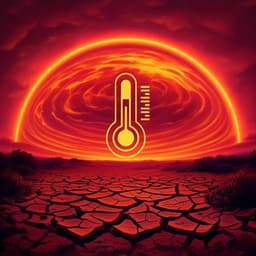
Economics
Global warming and heat extremes to enhance inflationary pressures
M. Kotz, F. Kuik, et al.
Discover how climate change may disrupt our economic stability! This insightful research, conducted by Maximilian Kotz, Friderike Kuik, Eliza Lis, and Christiane Nickel, reveals the persistent impacts of temperature on food and headline inflation across different income countries, emphasizing the pressing need to understand these dynamics as we approach 2035.
~3 min • Beginner • English
Introduction
The effects of climate change on the economy are increasingly well understood, with empirical studies demonstrating impacts on labour productivity, agricultural output, energy demand, and human health arising from historical weather fluctuations. These microeconomic impacts translate into macroeconomic consequences, with non-linear effects of average temperature, temperature variability, and precipitation on aggregate output quantified in historical data, implying considerable welfare losses under future climate change.
Despite this progress, the impacts of weather on inflation and the implications for inflation risks under future climate change remain understudied. Understanding these is crucial for assessing climate risk, as rising or unstable prices threaten economic and human welfare and political stability. The 2021/2022 cost-of-living crisis illustrates these stakes. Moreover, potential climate impacts on inflation dynamics are highly relevant for monetary policy and central banks’ ability to maintain price stability. A comprehensive assessment of climatic risks to inflation can guide mitigation and adaptation policy and inform monetary policy.
Previous work has linked historical weather fluctuations to inflation, identifying effects from average temperatures, temperature variability, and annual precipitation. However, implications under future climate change are largely unassessed. This study provides a comprehensive assessment of historical impacts of a broad set of weather conditions on inflation, allowing for heterogeneity across seasons and regions, and combines results with climate model projections to assess implications under future warming.
We pair national exposure to weather conditions using high-resolution ERA5 data with monthly price indices across 121 countries (1996–2021), yielding over 27,000 observations. Monthly CPI data enable analysis of temporal dynamics and seasonal heterogeneity in inflation responses to weather shocks. Using fixed-effects panel regressions, we identify plausibly causal effects of within-country weather fluctuations on month-on-month inflation (log CPI changes), with country fixed effects (capturing baseline climate and inflation), year fixed effects (capturing global shocks), and country-month fixed effects (capturing country-specific seasonality), plus country-specific time trends to avoid spurious correlations. These choices, alongside the exogenous nature of weather fluctuations, support a causal interpretation of results.
Literature Review
Prior studies document weather’s effects on economic activity, including labour productivity, agriculture, energy demand, human health, and aggregate output with non-linear temperature and precipitation effects. In the inflation literature, historical weather fluctuations have been linked to inflation via changes in average temperatures, temperature variability, and precipitation. Mukherjee and Ouattara report persistent temperature impacts on inflation in developed and developing countries; Faccia et al. find strongest effects in hot seasons on food inflation. However, comprehensive assessments of seasonal and regional heterogeneity and the translation of historical relationships to future climate conditions have been lacking. This paper advances the literature by modeling heterogeneity via interactions with baseline temperatures at monthly resolution and by evaluating future inflationary pressures under CMIP6 climate projections.
Methodology
Data: Monthly, non-seasonally adjusted CPI indices (headline, food, and other aggregates) for 121 countries from 1996–2021 (main dataset per Osbat et al.; robustness with World Bank inflation dataset). Dependent variable is month-on-month inflation measured as first difference of log CPI. Climate data include ERA5 daily temperature and precipitation (0.25° grid, 1990–2021), CRU TS v4.05 for SPEI estimation (1901–2021), and CMIP6 daily temperature and precipitation projections from 21 bias-adjusted, downscaled models under SSP126 and SSP585 (ISIMIP trend-preserving bias adjustment to W5E5).
Weather variables: (i) Monthly average temperature; (ii) Daily temperature variability within each month (standard deviation); (iii) Drought/wetness via SPEI (various scales/thresholds); (iv) Daily precipitation extremes (population exposure to relative exceedance of the grid-cell 99th percentile). National exposures are population-weighted aggregates from grid to country level. Weather variables enter contemporaneously and with 11 monthly lags.
Empirical design: Fixed-effects panel regressions exploiting within-country monthly variation, with country fixed effects (μ_c), date fixed effects (η_t), and country-month fixed effects (π_mt) to capture country-specific seasonality. Country-specific linear time trends (γ_c y) mitigate spurious correlations from common warming trends. Standard errors are clustered by country. Key interactions capture non-linear dependence on baseline temperatures by interacting weather shocks with baseline temperature levels. The model includes 0–11 lags of each weather variable to trace persistence and compute cumulative marginal effects over a year.
Robustness: Dynamic panel including 11 lags of inflation to address serial correlation; Driscoll–Kraay standard errors for cross-sectional dependence; controls for monetary policy framework transitions (Comprehensive Monetary Policy Framework data with 32 regime dummies); alternative CPI dataset (World Bank); income splits (above/below median income per capita); normalization by historical inflation volatility; alternative definition of temperature shocks relative to a 30-year moving average to test adjustment to changing climate. Information criteria (AIC/BIC) compare fixed vs moving baselines; results show limited historical adaptation.
Cumulative marginal effects: Computed by summing relevant lag coefficients, including interaction terms evaluated at specified baseline temperatures (e.g., 12°C, 21°C, 25°C) to characterize non-linearity and persistence.
Future impacts: Evaluate empirically estimated temperature effects under CMIP6 future monthly temperatures (population-weighted) for 30-year windows centered on 2035 and 2060. Report annual pressures by summing monthly impacts, with means and standard deviations across models. Uncertainty ranges combine empirical specification choices, emission scenarios, and climate model spread (mean ± 1 sd across models and min–max across specifications). For the 2022 European summer heat analysis, apply observed June–August 2022 temperatures to the response functions to estimate cumulative annual inflation impacts, then add projected summer warming to assess amplification in 2035 and 2060. Assumptions: ceteris paribus (no unprecedented adaptation, no targeted monetary policy reaction, no macroeconomic interactions or demographic/consumption-basket changes).
Key Findings
- Temperature increases cause non-linear, persistent increases in inflation, strongest in food prices but also present in headline inflation. A 1°C increase in monthly temperature at a hot baseline (e.g., 25°C) leads to a cumulative 0.17 percentage-point increase in food inflation over the following 12 months (central specification), with no reversal over the year.
- Non-linearity: Hotter months/regions exhibit larger upward impacts. High latitudes see upward pressure in summer and downward/weak pressure in winter; low latitudes experience upward pressure year-round.
- Other weather variables: Higher daily temperature variability increases food and headline inflation, with larger impacts where the seasonal temperature cycle is smaller (low latitudes). Effects persist up to 12 months (with larger errors over time). Excess wet conditions (SPEI) raise food and headline prices persistently; excess dry conditions raise prices mainly in hot months/regions and less persistently. Heavy daily precipitation extremes produce short-lived headline inflation pressures (significant at one-month horizon in hot months), but cumulative impacts are generally insignificant.
- Robustness: Results hold across dynamic panels, cross-sectional dependence corrections, monetary policy controls, income splits, normalization by historical inflation volatility, alternative CPI dataset, and alternative temperature-shock definitions (fixed vs moving baseline). Information criteria provide no strong preference for moving baselines, indicating limited historical adaptation.
- Future pressures (global averages): By 2035, upward pressures on food inflation are 1.49±0.45 p.p. per year (SSP126) and 1.79±0.54 p.p. per year (SSP585); headline inflation 0.76±0.23 (SSP126) and 0.91±0.28 p.p. per year (SSP585). Accounting for empirical specification, scenario, and model uncertainty yields ranges: food 0.92–3.23 p.p.p.y.; headline 0.32–1.18 p.p.p.y.
- Spatial patterns: Pressures are largest in the global south (Africa, South America), despite greater warming at higher latitudes, due to higher baseline temperatures driving vulnerability. Advanced economies also face substantial pressures by 2035 (e.g., 1–2 p.p.p.y. on food inflation in North America and Europe in the baseline specification).
- Scenario divergence: By 2060, strong divergence across scenarios; central estimates show a ~2.1 p.p.p.y. difference in global food inflation pressure between low and high emissions, with high-emission scenarios exceeding 4 p.p.p.y. in many regions.
- Seasonality: Low latitudes show relatively constant monthly pressures; Northern mid-latitudes (20–40°N) see much larger summer pressures (over twice winter). At >40°N, summer upward pressures coexist with winter downward pressures. Resulting alteration of seasonal cycles increases seasonal variability across most of the global south and the USA but reduces it across much of Europe and higher northern latitudes.
- Extreme events: The 2022 European summer heat raised annual food inflation by 0.67 p.p. (0.43–0.93) and headline by 0.34 p.p. (0.18–0.41). Under 2035 warming, an equivalent extreme summer would raise food inflation by ~1.0 p.p. (0.6–1.6) in SSP585 and ~0.9 p.p. (0.5–1.4) in SSP126—an amplification of 30–50% by 2035; by 2060, amplification could reach ~1.8 p.p. (1.0–3.2) under SSP585 (nearly 200%).
Discussion
The study demonstrates that fluctuations in average temperature, temperature variability, and hydrological extremes exert significant and persistent effects on inflation, particularly food inflation, thereby addressing the key question of how climate conditions influence price dynamics. The non-linear dependence on baseline temperature explains strong regional and seasonal heterogeneity, with low-latitude countries and summer months at high latitudes most vulnerable. These mechanisms imply that projected warming will produce persistent exogenous upward pressures on inflation, alter seasonal inflation patterns, and increase inflation heterogeneity and volatility.
The results are pertinent for monetary policy: persistent climate-driven pressures complicate inflation forecasting, blur distinctions between temporary and persistent shocks, and risk de-anchoring expectations. Heterogeneous impacts within currency unions (e.g., stronger pressures in Southern vs Northern Europe) may widen inflation differentials and complicate the calibration of a single monetary policy, with potential distributional and social cohesion implications. While historical adaptation appears limited, model-based explorations suggest that future adjustment to changing mean temperatures could reduce impacts under low-emission scenarios once temperatures stabilize; nonetheless, under high-emission pathways, sizable pressures persist even with such adjustment. Thus, mitigation can substantially lower long-run inflationary pressures, while adaptation—though helpful—may not fully offset them under strong warming.
Overall, the findings highlight the need to integrate weather and climate considerations into macroeconomic assessment and monetary policy frameworks, develop weather-dependent inflation forecasts, and plan for increased volatility and heterogeneity in inflation outcomes under climate change.
Conclusion
This paper provides causal evidence that higher temperatures and certain weather extremes raise food and headline inflation persistently, with stronger effects in hotter conditions and notable seasonal and regional heterogeneity. By combining global monthly CPI data with high-resolution weather observations in a fixed-effects framework and evaluating impacts under CMIP6 projections, the study quantifies future exogenous pressures on inflation: globally averaging 0.9–3.2 p.p.p.y. for food and 0.3–1.2 p.p.p.y. for headline by 2035, larger in low latitudes and with strong seasonality at high latitudes. The 2022 European heat event already contributed materially to inflation, and similar extremes are likely to have amplified impacts under future warming.
Policy implications include the need for central banks to account for climate-driven inflation pressures in modelling and decision-making, and for governments to consider both mitigation and adaptation strategies to protect price stability and welfare. Future research should: (i) use higher spatial-resolution price data to better capture precipitation-related effects and local impacts; (ii) analyze spillovers through trade and commodity markets; (iii) investigate sectoral price dynamics (e.g., electricity) and evolving energy systems; (iv) assess the efficacy and costs of adaptation measures (e.g., cooling, crop switching); and (v) integrate structural macroeconomic frameworks to explore interactions between climate, policy, and inflation dynamics.
Limitations
- Spatial aggregation: National-level CPI and climate exposures may mask localized precipitation impacts due to high spatial variability of rainfall; subnational price data could improve detection.
- Price coverage: Strongest results are for food and headline; other components (e.g., electricity) show suggestive but statistically weaker effects, potentially due to limited data and complex price-setting.
- Scope of projections: Estimated future pressures are ceteris paribus and are not inflation forecasts; they exclude macroeconomic interactions, demographic change, and changes in consumption baskets or policy responses.
- Adaptation: No explicit modeling of unprecedented future adaptation; historical evidence suggests limited adaptation to date. Adjustment to moving temperature baselines mitigates impacts in low-emission scenarios but does not eliminate them under high warming.
- Controls and frequency: Lack of monthly global macro controls (employment/output) limits mechanistic decomposition; dynamic panel and fixed effects mitigate confounding, but causal channels beyond weather remain abstracted.
- Climate uncertainties: Future impact estimates depend on climate model ensembles and emission scenarios; variability and extremes beyond mean shifts (e.g., changes in variability) are only partially considered.
Related Publications
Explore these studies to deepen your understanding of the subject.







